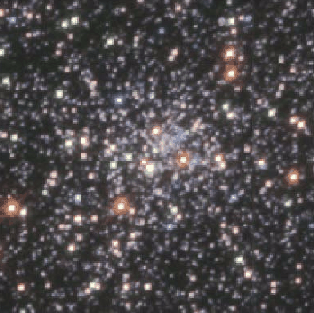Credit & Copyright: NASA,
P. Guhathakurta
(UCO/Lick Observatory, UC Santa Cruz)
Explanation:
Densely packed stars in the core of the globular cluster
M15 are shown
in this Hubble Space Telescope (HST)
image taken in April of 1994. The
stars revealed are contained in an area 1.6 light years across and
their colors roughly indicate their temperatures - hot stars
appear blue, cooler stars look reddish-orange. M15 has long been
recognized as one of the densest cluster of stars in our galaxy outside of
the galactic center itself.
Even the unprecedented resolving
power of the HST cameras could not separate the individual stars in its
innermost regions. However,
this HST image reveals that the density of stars continues
to rise toward the cluster's core, suggesting that a sudden,
runaway collapse due to the gravitational attraction of many closely
packed stars or a single central massive object, perhaps a
black hole,
could account for the core's extreme density.
1999 2000 2001 2002 2003 2004 2005 2006 2007 2008 2009 2010 2011 2012 2013 2014 2015 2016 2017 2018 2019 2020 2021 2022 2023 2024 2025 |
Yanvar' Fevral' Mart Aprel' Mai Iyun' Iyul' Avgust Sentyabr' Oktyabr' Noyabr' Dekabr' |
NASA Web Site Statements, Warnings, and Disclaimers
NASA Official: Jay Norris. Specific rights apply.
A service of: LHEA at NASA / GSFC
& Michigan Tech. U.
|
Publikacii s klyuchevymi slovami:
M 15 - Sharovoe skoplenie - chernye dyry
Publikacii so slovami: M 15 - Sharovoe skoplenie - chernye dyry | |
Sm. takzhe:
Vse publikacii na tu zhe temu >> | |
